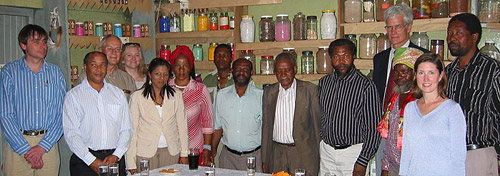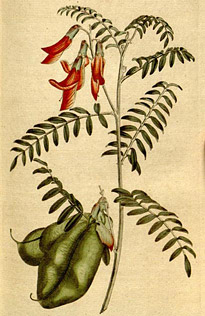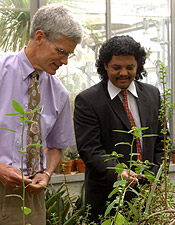International Team Studies South African Plant for HIV/AIDS
"It's just overwhelming. It feels like anything you do is a drop in a huge, huge bucket. But, you drop a drop, and it causes a ripple, and that causes a lot of change. Sometimes you have to be a drop, because that's all you've got."
So Kathleen Goggin, Ph.D., describes part of what draws her to co-lead a groundbreaking study of an African traditional medicine. A plant called Sutherlandia is being examined for its potential to help patients with HIV infection. The study is being cosponsored by NCCAM and NIH's Office of AIDS Research, Office of Dietary Supplements, and Fogarty International Center.
According to the joint United Nations program on HIV/AIDS, or UNAIDS, about 33.2 million people worldwide have HIV infection. AIDS is among the leading causes of death worldwide.

A group of contributors to the Sutherlandia study met in September 2007 in Pietermaritzburg,
KwaZulu-Natal, South Africa. Left to right: Douglas Wilson, James Syce, Kevin Rudeen,
Laurie Ben-yair, Tilly Pillay, Makhosi Msomi, Thulani Hlongwa, Baba Shange, Baba Thabethe,
Elliot Makhathini, Bill Folk, Makhosi Xaba, Deborah Hayes, and Makhosi Dlamini.
The photo’s setting is a shop for supplies for traditional inyanga healing.
Courtesy of Kathleen Goggin
South Africa is one of the countries that have been hardest hit by HIV/AIDS. While changes in South Africa have been taking place (including a new national strategic plan for AIDS) to help prevent transmission of the virus and to treat those who are infected, the challenges are large in scale. UNAIDS states that in South Africa by the end of 2006:
- About 5½ million people (or one in nine) were living with HIV infection. Almost one-quarter million of them were children under 15 years old.
- More than 360,000 people were taking antiretroviral therapy (ART).
- For every person in South Africa who begins taking ART, three more become infected with HIV.
Could a Plant Be Helpful?

Lessertia frutescens
(Sutherlandia)
William Curtis (1792), courtesy of the Missouri Botanical Garden
Working to create a ripple in the pandemic's bucket are an international team of Western-trained clinicians and researchers from both the United States and South Africa (see box below) as well as South African traditional healers. The plant they are studying, Sutherlandia, is a member of the pea family, uniquely native to South Africa, and wild-growing in places there. Its scientific name is Lessertia frutescens; some of its popular names are Insisa, Unwele, Phetola, and cancer bush.
Walk into any South African traditional medicine market, and there it is—alongside the other herbs, barks, pieces of wood, animal bones and teeth, and other products sold and traded for medicinal purposes. Sutherlandia is used to make traditional medicine believed to be helpful for many health problems—such as infections (including HIV), inflammation, depression, cancer, and stress effects—and as a wellness tonic. It is also available in South African drugstores and in some other countries such as the United States, where it is sold as a dietary supplement.
This randomized, placebo-controlled study is looking at Sutherlandia's safety in a group of 124 volunteers who are at an early stage of HIV infection and do not qualify for government-sponsored ART. The researchers will also collect data that could shed light on the plant's usefulness in treating some of the symptoms of HIV infection. The participants who receive Sutherlandia will take by mouth a preparation made from ground leaves and specially formulated for the study. The study will be conducted at Edendale Hospital, a large county hospital located in Pietermaritzburg, KwaZulu-Natal, South Africa, and affiliated with the Nelson R. Mandela School of Medicine.
Jack Killen, M.D., Acting Deputy Director of NCCAM and Director of NCCAM's Office of International Health Research, said, "Many people are using this plant in South Africa, where it originated, and where traditional healers are commonly the first and/or the only medical care option." He added, "Not much is known yet about Sutherlandia scientifically, including whether and how it works.We hope to learn a good deal from this study about Sutherlandia specifically and about the best practices for rigorous research on traditional medicines more generally."
Centers That Study Traditional/Indigenous Therapies
The Sutherlandia study is a key project of one of NCCAM's Centers for International Research on CAM: The International Center for Indigenous Phytotherapy Studies (TICIPS) on HIV/AIDS, Secondary Infections, and Immune Modulation. This center is a partnership between many institutions:
University of the Western Cape
University of Cape Town
University of KwaZulu-Natal
Medical Research Council of South Africa
University of Missouri, Columbia
University of Missouri, Kansas City
Missouri Botanical Garden
Georgetown University
University of Texas Medical Branch at Galveston
TICIPS also plans to study African wormwood (Artemisia afra), another traditional South African medicine, for its potential usefulness against tuberculosis and cervical cancer.

Dr. Bill Folk (left)
and Dr. Quinton Johnson
© University of Missouri
School of Medicine
TICIPS and Study Leaders
Key personnel include William Folk, Ph.D., principal investigator and TICIPS co-director, who is professor of biochemistry at the University of Missouri, Columbia, and associate dean for research at its school of medicine. Quinton Johnson, Ph.D., is TICIPS co-director and director of the South African Herbal Science and Medicine Institute at the University of the Western Cape. Co-leaders of the Sutherlandia study are Kathleen Goggin, Ph.D., associate professor of psychology at the University of Missouri, Kansas City, and Douglas Wilson, M.B.Ch.B., F.C.P., head of the Department of Medicine at Edendale Hospital. Nceba Gqaleni, Ph.D., is the Department of Science and Technology/National Research Foundation Research Chair on Indigenous Health Care Systems, Nelson R. Mandela School of Medicine, University of KwaZulu-Natal. James Syce, Ph.D., is professor of pharmacy at the University of the Western Cape.
NCCAM's international centers are designed to examine complementary, alternative, and traditional medical therapies in the environments where they originated and have the longest tradition of use. In South Africa, that environment is "one of the most botanically diverse and rich regions in the world," says Dr. Folk. South Africa has over 20,000 indigenous species of plants, several thousand of which are used for health purposes by traditional healers.
A Traditional System That Millions Rely Upon
South African traditional medicine dates back to ancient times. It has been recognized by the South African government as a key part of that country's health care system. It is estimated that in South Africa, there are about 200,000 traditional healers, and about 80 percent of the population (which numbers about 48 million, with 18 languages and many cultures) uses these healers for their primary health care.
African traditional medicine is too complex to describe fully in this article, but a few of its aspects include:
- The approach is holistic, focusing on the whole person rather than on particular organs or disorders.
- Body, spirit, and environment are all taken into consideration.
- Many traditional healers use rituals, herbs and other naturally derived medicines, divination (obtaining information through what is believed to be supernatural means), offerings, faith healing, and purgative approaches such as enemas and incisions.
- The different types of traditional healers include inyangas, who are especially skilled in natural medicines; sangomas, spiritualists who counsel and heal through communication with ancestral spirits; traditional birth attendants; and traditional surgeons.
Western medicine is also available in South Africa, including at Edendale Hospital, but it can be challenging to obtain for many reasons, including distance (close to 50 percent of South Africa's population lives in nonurban areas) and a shortage of Western-trained doctors, nurses, and other health staff. In the district of Mount Frere, for example, there is one Western doctor for every 30,000 residents.
A Carefully Designed Research Collaboration
Traditional healers in South Africa are collaborating in research with allopathic team members at every stage of the Sutherlandia study—from developing the research questions through analyzing, interpreting, and sharing the results. This reflects not only a level of commitment but the use of, and training in, a research strategy called community-based participatory research.
Dr. Goggin says, "The traditional health providers are helping us in so many ways. They have helped give legitimacy to the study. They partnered with us in translation and in developing outcome measures. They will be helping us with patient retention. Above all, they are willing to try. For 1,000 years, people have taken things from their traditional and indigenous medicine—stolen [them] and walked away. Our colleagues are trusting that we are not going to do that and we will work hand in hand." The study is designed to ensure compliance with U.S. and South African regulations on the conduct of research, financial disclosure, conflict of interest, and international property rights.
Adapting for Culture
Dr. Goggin recalls a key aspect of the study in which all the members of the team, as well as additional groups of traditional healers, offered their expertise to adapt tools for the study.
They were going to need quantifiable outcome measures—including for perceived stress, symptoms of depression, and quality of life, all of which have cultural associations. The U.S. researchers began with some standard scales and the 10 "good practice" steps developed by the International Society for Pharmacoeconomics and Outcomes Research. How would these translate in the context of Zulu South Africa?
Dr. Goggin says, "We did focus groups with traditional healers who are culturally Zulu and speak isiZulu. Many also speak English, but isiZulu is their primary language and the one they use when treating clients and seeing patients. They helped us to figure out what our measures should be."
She continues, "There was no easy translation for any of the items on the depression measure, for example. There's no single word for depression in isiZulu. So, when we talked about the concept of depression, we asked, 'When someone is having a lot of worries and stress and is not feeling well, what is that called?' They came to consensus on a term, umoya uphansi.
"Then we asked, 'What would those people look like and be like?' And they came up with every single symptom of depression. We used the CES-D [one of the screening tests for depression, developed by the Center for Epidemiologic Studies, National Institute of Mental Health], which does not include an item on sexual dysfunction. The traditional healers added sexual dysfunction on their own."
When it came to a term for quality of life, the traditional healers agreed on izinga/iqophelo lempilo, which Dr. Goggin says means "spirit of life… It's very, very close to our concept, but they don't think of quality of life as a thing. It's something that somebody strives for at all times. Everyone would want 'quality of life.'"
There were many steps by the team members to review and revise questionnaires to be used in the study. For example, the versions of isiZulu spoken in two cities that are 45 minutes apart, Pietermaritzburg and Durban, turned out to be significantly different.
The Experience So Far
Dr. Goggin and her colleagues learned from talking to traditional healers, she says, that "Sutherlandia is a powerful part of their muthis [or mutis, traditional medicine formulas], and they use it often. They don't use Sutherlandia on its own, but in combinations with other herbs. It is believed to have an impact on gastrointestinal distress, especially in reducing nausea and increasing appetite. That may be true, at least from some of the early studies that have been done in animals and in our previous phase I study [on safety in healthy adults]. With increased eating, one often sees an increase in mood and in quality of life."
Although Sutherlandia is widely used, Dr. Folk says, previously there was no solid research evidence of its safety and effectiveness, including in HIV/AIDS. He notes there is some preliminary scientific evidence that this herb can help treat infections, such as bronchitis or the common cold—and also some laboratory evidence that Sutherlandia has "significant interactions" with ART drugs (in other words, taking them together could alter the effectiveness or side effects of ART).
Dr. Folk says that he has found it particularly rewarding so far "to assist in the development of the collaboration in research between traditional healers and physicians, which will undoubtedly improve care." Dr. Goggin appreciates "having had the opportunity to work with and learn from my colleagues in South Africa and being part of this historic trial." She adds that she finds South Africa to be "an amazing place. People there are generally just the most warm, open, and inviting people you'll ever meet."
Is Sutherlandia Safe?
The TICIPS team first carried out a small, randomized, double-blind, placebo-controlled safety study of Sutherlandia in a group of 25 healthy volunteers. Dr. Quinton Johnson and his colleagues found it to be well tolerated, with no clinically significant differences in side effects seen between the group who received the Sutherlandia and the group who received a placebo, except that the Sutherlandia group showed indications of an increase in appetite. They noted that in an earlier study in vervet monkeys, Sutherlandia was given at nine times a typical dose and no adverse effects occurred. They suggested that Sutherlandia's potential benefits might be attributed to one or more of the following ingredients: D-pinitol (a simple sugar often found in legumes), GABA (gabba-amino butyric acid, an amino acid and a neurotransmitter), and L-canavanine (an amino acid).
There is very limited information about Sutherlandia's safety and side effects in the peer-reviewed literature. However, among the common points in two evidence-based reviews are that:
- Sutherlandia has a long history in Africa of apparently safe use.
- Its known side effects include mild diarrhea, dry mouth, increased urination, and (in people who have wasting and weakness from disease) dizziness.
- There are indications that Sutherlandia interacts with ART.
- The safety of the ingredient L-canavanine is a controversial area. It may have an association with lupus and a lupus-like syndrome—a concern that appears to be based largely on a case report, and some laboratory and animal studies, on L-canavanine in another legume plant, alfalfa (Medicago sativa). One of the reviews cites a South African reference reporting rare instances of birth defects and induction of abortion from L-canavanine. In short, the safety of L-canavanine is controversial—more high-quality studies are needed.
- Very little is known scientifically about the safety of D-pinitol and GABA.
Sources
Babb DA, Pemba L, Seatlanyane P, et al. Use of traditional medicine by HIV-infected individuals in South Africa in the era of antiretroviral therapy. Psychology, Health and Medicine. 2007;12(3):314-320.
Bottom Line Monograph: Alfalfa. Natural Standard database. Accessed at http://www.naturalstandard.com on October 9, 2007.
GABA (Gamma-Aminobutyric Acid). Natural Medicines Comprehensive Database. Accessed at http://www.naturaldatabase.com on October 9, 2007.
Giarelli E, Jacobs LA. Traditional healing and HIV-AIDS in KwaZulu-Natal, South Africa. American Journal of Nursing. 2003;103(10):36-46.
Goggin K., Mbhele AL, Makhathini ME, et al. The translation and cultural adaptation of patient-reported outcome measures: a report from the field. 2007. [Unpublished manuscript]
Goggin K, Pinston M, Gqaleni N, et al. The role of South African traditional health practitioners in HIV/AIDS prevention and treatment. 2007 [in press]. In Pope C, White R, Malow R (Eds.) Globalization of HIV/AIDS: An Interdisciplinary Reader. New York: Routledge.
Johnson Q, Syce J, Nell H, et al. A randomized, double-blind, placebo-controlled trial of Lessertia frutescens in healthy adults. PloS Clinical Trials. 2007;2(4)e6.
Mills E, Cooper C, Seely D, et al. African herbal medicines in the treatment of HIV: Hypoxis and Sutherlandia: An overview of evidence and pharmacology. Nutrition Journal. 2005;4(19):1-6.
Morris K. Treating HIV in South Africa: a tale of two systems. Lancet. 2001;357:1190.
Ngubane H. Aspects of clinical practice and traditional organization of indigenous healers in South Africa. Social Science and Medicine. Part B, Medical Anthropology. 1981;15B:361-365.
Puckree R, Mkhize M, Mgobhozi Z, et al. African traditional healers: what health care professionals need to know. International Journal of Rehabilitation Research. 2002;25:247-251.
UNAIDS. AIDS epidemic update: December 2007. Accessed at http://data.unaids.org/pub/EpiSlides/2007/2007_epiupdate_en.pdf on December 4, 2007.
UNAIDS. Uniting the world against AIDS: South Africa. June 2007. Accessed at http://www.unaids.org/en/CountryResponses/Countries/south_africa.asp on October 12, 2007.
Advancing Global Health
In its Strategic Plan for 2005–2009, NCCAM describes its interest in:- Advancing the understanding of traditional/indigenous medical systems (which may also be used as CAM) through multidisciplinary collaborative studies
- Contributing to the preservation of irreplaceable and valuable knowledge about them
- Enhancing understanding of how best to integrate them with "conventional" medical interventions.
